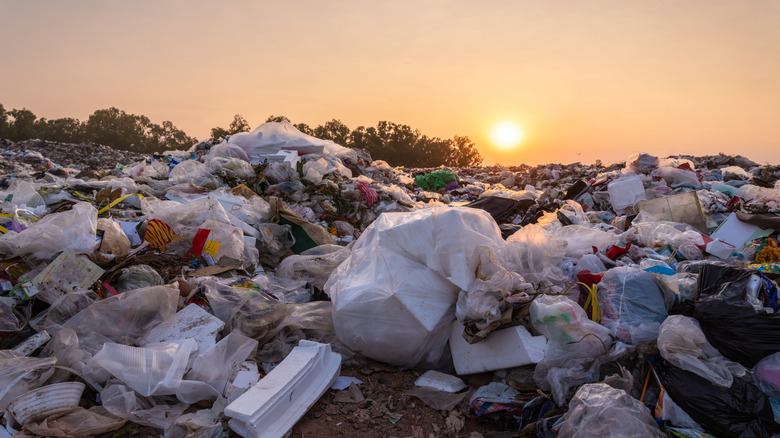What Are Forever Chemicals?
The lifespans of chemical compounds vary wildly; some biodegrade quickly, making them environmentally friendly materials, but some things will not decompose, meaning whatever harmful effects they may have on their environment are impossible to escape from. The study of so-called "forever chemicals" has become one of the most alarming scientific stories to emerge in the 21st century, as it turns out that synthetic compounds have leached into nearly every nook and cranny of the Earth, and they have seriously dangerous potential.
When scientists talk about "forever chemicals," they are specifically referring to a group of lab-produced compounds called perfluoroalkyl and polyfluoroalkyl substances, better known as PFAS. These chemicals generally don't react with other chemicals, which makes them incredibly good at repelling oil and water and resisting heat. Beginning in the 1940s, PFAS gained widespread use in a vast array of consumer products, including nonstick cookware, food packaging, cleaning products, waterproof clothes, and cosmetics. They also have industrial uses in jet engines, fire hose foam, and refrigerators.
Humans have released vast amounts of PFAS into the environment, and because these chemicals resist interacting with others, they can take hundreds or thousands of years to break down. PFAS have accumulated so much that they have infiltrated virtually every human's body, and a growing corpus of research links them to health issues like high cholesterol levels, immunodeficiencies, and multiple forms of cancer. At this point, PFAS are unavoidable, so it's time to get familiar with them, and what, if anything, can be done about them.
The most common PFAS
There are thousands of different PFAS, but two of them have garnered particular scrutiny due to their widespread use. They are perfluorooctanoic acid (PFOA) and perfluorooctane sulfinate (PFOS), sometimes grouped under the name C8. PFOA has been used the most, with its most notorious application being the thermoplastic cookware coating, Teflon, invented by DuPont. The most infamous applications of PFOS have been by 3M, which used it in a Scotchguard (a protective coating applied to many fabrics), Scotchban (a product used in food packaging), and in firefighting foam.
Concerns about the health impacts of PFAS arose in the 1960s and '70s after several workers at plants run by DuPont and 3M fell ill. Both companies conducted internal studies that linked PFAS to health problems like liver damage and prostate cancer. However, DuPont and 3M willfully hid the results of these studies in order to protect their profits. It wasn't until the 1990s, when independent scientists began recording PFAS in ground water, that the dangers were finally revealed to the public.
Some important actions were taken after the dangers of PFAS came to light. DuPont and 3M had to pay multibillion dollar settlements, and both PFOA and PFOS were banned from being manufactured in the United States. However, because PFOA and PFOS are forever chemicals, they remain in the environment. Plus, other countries still allow their manufacture, while in the United States, they have just been replaced with different PFAS that could likely have the same issues.
Can anything be done about PFAS?
Unfortunately, it is impossible to avoid exposure to PFAS in today's world. In addition to their historic presence in food packaging, they are also found in farm fertilizers, which can introduce them directly into crops, and from there into your body. As if that weren't enough, PFAS run rampant in surface and subsurface water. An interactive map from the Environmental Working Group shows high levels of PFAS contamination in drinking water roughly coinciding with the population distribution.
In the United States, the National Health and Nutrition Examination Survey has tracked the levels of PFAS in people's blood since 1999. The most recent data released by the Agency for Toxic Substances and Disease Registry shows that PFAS are present in the blood of 95% of the general population. People are now born with contaminated blood because PFAS can be transferred to a fetus during pregnancy, ensuring that these forever chemicals get passed down through generations. It is worth noting, however, that levels of contamination per person have gone down since data collecting began in 1999.
The U.S. government has steadily added regulations against PFAS use, including introducing a rule that every public water system must establish PFAS monitoring systems by 2027 and make their records public. However, the EPA is only authorized to regulate individual chemicals, not entire chemical classes, and because there are literally thousands of PFAS, studying and controlling each and every forever chemical could become a forever process.


